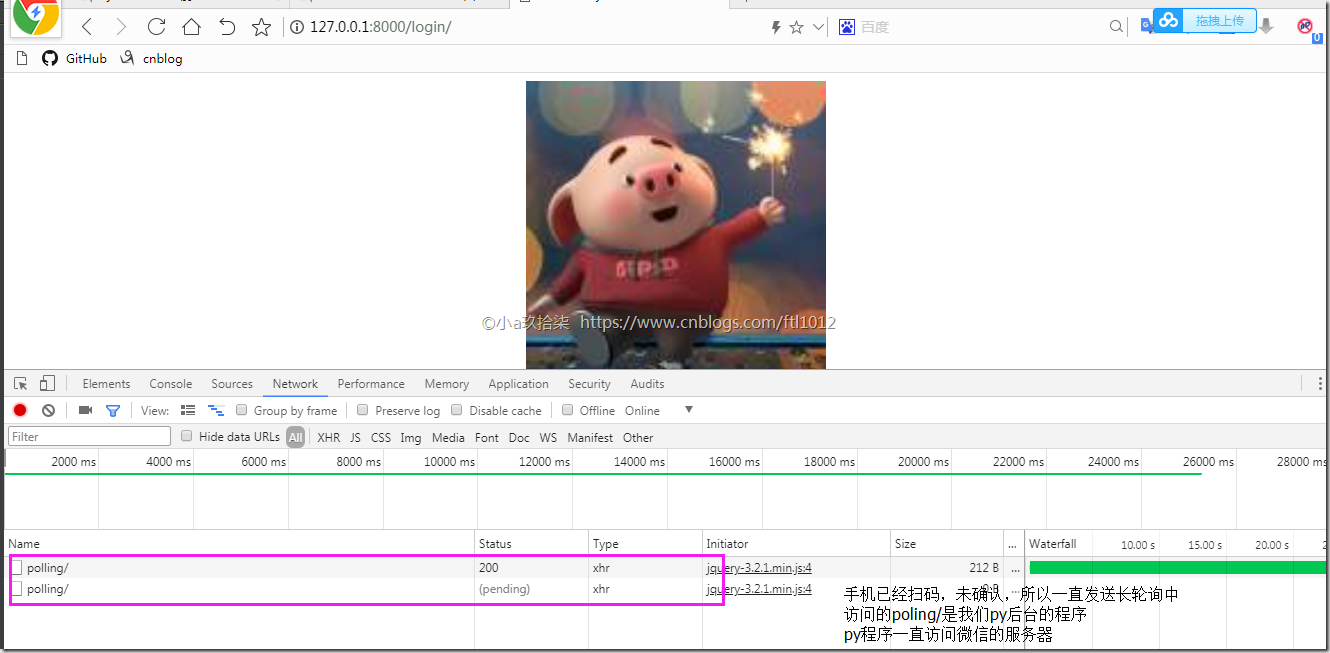第三步: 实现长轮询访问服务器---day2代码
settings.py
"""
Django settings for weixin project.
Generated by 'django-admin startproject' using Django 2.0.1.
For more information on this file, see
https://docs.djangoproject.com/en/2.0/topics/settings/
For the full list of settings and their values, see
https://docs.djangoproject.com/en/2.0/ref/settings/
"""
import os
# Build paths inside the project like this: os.path.join(BASE_DIR, ...)
BASE_DIR = os.path.dirname(os.path.dirname(os.path.abspath(__file__)))
# Quick-start development settings - unsuitable for production
# See https://docs.djangoproject.com/en/2.0/howto/deployment/checklist/
# SECURITY WARNING: keep the secret key used in production secret!
SECRET_KEY = '*g4b=9ct3o#*1pr0o2$h+p$eb!czq!)83u933x8$(n7uj++!f%'
# SECURITY WARNING: don't run with debug turned on in production!
DEBUG = True
ALLOWED_HOSTS = []
# Application definition
INSTALLED_APPS = [
'django.contrib.admin',
'django.contrib.auth',
'django.contrib.contenttypes',
'django.contrib.sessions',
'django.contrib.messages',
'django.contrib.staticfiles',
'App.apps.AppConfig',
]
MIDDLEWARE = [
'django.middleware.security.SecurityMiddleware',
'django.contrib.sessions.middleware.SessionMiddleware',
'django.middleware.common.CommonMiddleware',
# 'django.middleware.csrf.CsrfViewMiddleware',
'django.contrib.auth.middleware.AuthenticationMiddleware',
'django.contrib.messages.middleware.MessageMiddleware',
'django.middleware.clickjacking.XFrameOptionsMiddleware',
]
ROOT_URLCONF = 'weixin.urls'
TEMPLATES = [
{
'BACKEND': 'django.template.backends.django.DjangoTemplates',
'DIRS': [os.path.join(BASE_DIR, 'templates')],
'APP_DIRS': True,
'OPTIONS': {
'context_processors': [
'django.template.context_processors.debug',
'django.template.context_processors.request',
'django.contrib.auth.context_processors.auth',
'django.contrib.messages.context_processors.messages',
],
},
},
]
WSGI_APPLICATION = 'weixin.wsgi.application'
# Database
# https://docs.djangoproject.com/en/2.0/ref/settings/#databases
DATABASES = {
'default': {
'ENGINE': 'django.db.backends.sqlite3',
'NAME': os.path.join(BASE_DIR, 'db.sqlite3'),
}
}
# Password validation
# https://docs.djangoproject.com/en/2.0/ref/settings/#auth-password-validators
AUTH_PASSWORD_VALIDATORS = [
{
'NAME': 'django.contrib.auth.password_validation.UserAttributeSimilarityValidator',
},
{
'NAME': 'django.contrib.auth.password_validation.MinimumLengthValidator',
},
{
'NAME': 'django.contrib.auth.password_validation.CommonPasswordValidator',
},
{
'NAME': 'django.contrib.auth.password_validation.NumericPasswordValidator',
},
]
# Internationalization
# https://docs.djangoproject.com/en/2.0/topics/i18n/
LANGUAGE_CODE = 'en-us'
TIME_ZONE = 'UTC'
USE_I18N = True
USE_L10N = True
USE_TZ = True
# Static files (CSS, JavaScript, Images)
# https://docs.djangoproject.com/en/2.0/howto/static-files/
STATIC_URL = '/static/'
TEMPLATE_DIRS = (os.path.join(BASE_DIR, 'templates'),)
STATICFILES_DIRS = (
os.path.join(BASE_DIR, 'static'),
)
views.py
from django.shortcuts import render, redirect, HttpResponse
import re
import time
import json
import requests
# Create your views here.
QCODE = None
CURRENT_TIME = None
LOGIN_COOKIE_DICT = {}
TICKET_COOKIE_DICT = {}
TICKET_DICT = {}
TIP = 1 # 解决201后还不停pending的问题...
USER_INIT_DATA = {}
BASE_URL = "http://wx.qq.com"
BASE_SYNC_URL = "https://webpush.weixin.qq.com"
def login(request):
# https://login.wx.qq.com/jslogin?appid=wx782c26e4c19acffb&redirect_uri=https%3A%2F%2Fwx.qq.com%2Fcgi-bin%2Fmmwebwx-bin%2Fwebwxnewloginpage&fun=new&lang=zh_CN&_=1486951705941
base_qode_url = 'https://login.wx.qq.com/jslogin?appid=wx782c26e4c19acffb&redirect_uri=https%3A%2F%2Fwx.qq.com%2Fcgi-bin%2Fmmwebwx-bin%2Fwebwxnewloginpage&fun=new&lang=zh_CN&={0}'
global CURRENT_TIME # 更改全局变量需要更改添加global
global QCODE
CURRENT_TIME = str(time.time()) # 时间戳【返回是float类型,转换为str类型】
q_code_url = base_qode_url.format(CURRENT_TIME)
response = requests.get(q_code_url) # 获取到随记字符串,返回是个response对象
# code: <Response [200]>
# type(code): <class 'requests.models.Response'>
# code.text : window.QRLogin.code = 200; window.QRLogin.uuid = "gb8OTUPMpA==";
print('Response对象: ', response, type(response))
print('Response内容: ', response.text)
code = re.findall('uuid = "(.*)"', response.text)[0] # findall返回一个列表,注意空格
QCODE = code
print("随记字符:", QCODE)
return render(request, 'login.html', {"code": QCODE})
def pooling(request):
# https://login.wx.qq.com/cgi-bin/mmwebwx-bin/login?loginicon=true&uuid=AY0FL0UZwA==&tip=1&r=1700853510&_=1523012536082
# 201: 扫码,未确认
# 200: 扫码,确认
# 408: 等待中...
global TIP # 解决201后还不停pending的问题...
ret = {'status': 408, 'data': None}
base_login_url = "https://login.wx.qq.com/cgi-bin/mmwebwx-bin/login?loginicon=true&uuid={0}&tip={1}&r=-1700853510&_={2}"
login_url = base_login_url.format(QCODE, TIP, CURRENT_TIME)
response_login = requests.get(login_url)
print('长轮询URL', login_url)
print('长轮询状态码以及内容:', response_login.text)
if 'window.code=201' in response_login.text:
userAvatar = re.findall("userAvatar = '(.*)';", response_login.text)[0]
ret['data'] = userAvatar
ret['status'] = 201
TIP = 0
elif 'window.code=200' in response_login.text:
global BASE_URL
global BASE_SYNC_URL
# 用户已经确认后获取Cookie内容
LOGIN_COOKIE_DICT.update(response_login.cookies.get_dict())
redirect_url = re.findall('window.redirect_uri="(.*)";', response_login.text)[0]
if redirect_url.startswith('https://wx2.qq.com'):
BASE_URL = 'https://wx2.qq.com'
BASE_SYNC_URL = 'https://webpush.wx2.qq.com'
else:
BASE_URL = "http://wx.qq.com"
BASE_SYNC_URL = "https://webpush.weixin.qq.com"
# 微信正常的:https://wx.qq.com/cgi-bin/mmwebwx-bin/webwxnewloginpage?ticket=ATsWUC3qlrRteYUWzz_8hBMH@qrticket_0&uuid=QY2NxTcDcw==&lang=zh_CN&scan=1523018755&fun=new&version=v2&lang=zh_CN
# 我们获取的:https://wx.qq.com/cgi-bin/mmwebwx-bin/webwxnewloginpage?ticket=AYTBkpgzEWsIgHOjaQK1tvSs@qrticket_0&uuid=AfxTcp1JXQ==&lang=zh_CN&scan=1523017763
print('用户确认后获取的URL:', redirect_url)
redirect_url += '&fun=new&version=v2&lang=zh_CN'
print('用户确认后改装的跳转URL:', redirect_url)
# 用户已经确认后获取票据内容
response_ticket = requests.get(redirect_url, cookies=LOGIN_COOKIE_DICT)
TICKET_COOKIE_DICT.update(response_ticket.cookies.get_dict())
'''
获取的凭据内容:
<error>
<ret>0</ret>
<message></message>
<skey>@crypt_ea9ae4c7_090ef27aeb8539e92003afd7658c8f49</skey>
<wxsid>dDQOkKqhrvLnFm1o</wxsid>
<wxuin>1289256384</wxuin>
<pass_ticket>YWQzZ0sOdkr1Eq%2BExvGbyfBq2mbIwksh%2BipMvTyNVUxBwnfqhXKn4wTBPMhpHh%2B%2F</pass_ticket>
<isgrayscale>1</isgrayscale>
</error>
'''
print('获取的凭据内容: ', response_ticket.text) # 利用这个凭据进行下一次的数据访问
'''
格式化输出凭据内容
ret 0
message None
skey @crypt_29bab75e_996fb921b5a09570d7793598f2e213dc
wxsid g++XySA396Bnwljx
wxuin 1600696821
pass_ticket fbBFzsSbFhlD1kpNMJ7f39vrBwGqZTezGU7%2FpDZS1rzAueLDfKw%2FfoWp8sT8MdP6
isgrayscale 1
'''
from bs4 import BeautifulSoup
soup = BeautifulSoup(response_ticket.text, 'html.parser')
for tag in soup.find(): # 格式化打印XML内容
TICKET_DICT[tag.name] = tag.string # 字典内部元素修改不需要global,重新赋值需要global
ret['status'] = 200 # 解决我们后台的报错问题,因为前台一直在pending获取数据根后台我们拿到的数据不一致
return HttpResponse(json.dumps(ret))
url.py
from django.contrib import admin
from django.urls import path
from App import views
urlpatterns = [
path('admin/', admin.site.urls),
path('login/', views.login),
path('polling/', views.pooling),
]
login.html
<!DOCTYPE html>
<html lang="en">
<head>
<meta charset="UTF-8">
<title>WeChat By FTL1012</title>
</head>
<body>
<div style="width: 300px; margin: 0 auto ">
<img id="qcode" style="width: 300px; height: 300px;" src="https://login.weixin.qq.com/qrcode/{{ code }}"/>
</div>
</body>
<script src="/static/jquery-3.2.1.min.js"></script>
<script>
$(function () {
polling();
});
// 发送长轮询
function polling() {
$.ajax({
url: '/polling/',
type: "GET",
dataType: 'json',
success: function (args) {
if(args.status == 408){
polling();
}else if(args.status == 201){
// 已经扫描,但未确认; --》获取微信用户的头像信息,继续发长轮询等待确认
$("#qcode").attr('src', args.data);
polling();
}else{
// 此时手机端已经确认了信息,跳转主页面
location.href = '/index/'
}
}
})
}
</script>
</html>页面请求:
http://127.0.0.1:8000/login/(扫码后)
长轮询的状态码408






















 1695
1695











 被折叠的 条评论
为什么被折叠?
被折叠的 条评论
为什么被折叠?








